Polar Capital Technology Trust plc (the "Company"): The Company is an investment company with investment trust status and its shares are excluded from the Financial Conduct Authority’s (“FCA”) restrictions on the promotion of non-mainstream investment products. The Company conducts its affairs, and intends to continue to conduct its affairs, so that the exemption will apply.
The Company is an Alternative Investment Fund under the EU's Alternative Investment Fund Managers Directive 2011/61/EU as it forms part of UK law by virtue of the European Union (Withdrawal) Act 2018.
The Investment Manager: Polar Capital LLP is the investment manager of the Company (the "Investment Manager"). The Investment Manager is authorised and regulated by the FCA and is a registered investment adviser with the United States' Securities and Exchange Commission.
Key Risks
- Investors' capital is at risk and there is no guarantee the Company will achieve its objective.
- Past performance is not a reliable guide to future performance.
- The value of investments may go down as well as up.
- Investors might get back less than they originally invested.
- The value of an investment’s assets may be affected by a variety of uncertainties such as (but not limited to): (i) international political developments; (ii) market sentiment; and (iii) economic conditions.
- The shares of the Company may trade at a discount or a premium to Net Asset Value.
- The Company may use derivatives which carry the risk of reduced liquidity, substantial loss and increased volatility in adverse market conditions.
- The Company invests in assets denominated in currencies other than the Company's base currency and changes in exchange rates may have a negative impact on the value of the Company's investments.
- The Company invests in a concentrated number of companies based in one sector. This focused strategy can lead to significant losses. The Company may be less diversified than other investment companies.
- The Company may invest in emerging markets where there is a greater risk of volatility than developed economies, for example due to political and economic uncertainties and restrictions on foreign investment. Emerging markets are typically less liquid than developed economies which may result in large price movements to the Company.
Important Information
Not an offer to buy or sell: This document is not an offer to buy or sell or a solicitation of an offer to buy or sell any security, and under no circumstances is it to be construed as a prospectus or an advertisement. This document does not constitute, and may not be used for the purposes of, an offer of the securities of, or any interests in, the Company by any person in any jurisdiction in which such offer or invitation is not authorised.
Information subject to change: Any opinions expressed in this document may change.
Not Investment Advice: This document does not contain information material to the investment objectives or financial needs of the recipient. This document is not advice on legal, taxation or investment matters. Prospective investors must rely on their own examination of the consequences of an investment in the Company. Investors are advised to consult their own professional advisors concerning the investment.
No reliance: No reliance should be placed upon the contents of this document by any person for any purposes whatsoever. None of the Company, the Investment Manager or any of their respective affiliates accepts any responsibility for providing any investor with access to additional information, for revising or for correcting any inaccuracy in this document.
Performance and Holdings: All data is as at the document date unless indicated otherwise. Company holdings and performance are likely to have changed since the report date. Company information is provided by the Investment Manager.
Benchmark: The Company is actively managed and uses the Dow Jones Global Technology Index (total return, Sterling adjusted) as a performance target. The benchmark is considered to be representative of the investment universe in which the Company invests. The performance of the Company is likely to differ from the performance of the benchmark as the holdings, weightings and asset allocation will be different. Investors should carefully consider these differences when making comparisons. Further information about the benchmark can be found at: https://www.spglobal.com/spdji/en/indices/equity/dow-jones-us-technology-index/#overview.
Third-party Data: Some information contained in this document has been obtained from third party sources and has not been independently verified. Neither the Company nor any other party involved in compiling, computing or creating the data makes any warranties or representations with respect to such data, and all such parties expressly disclaim all warranties of originality, accuracy, completeness, merchantability or fitness for a particular purpose with respect to any data contained within this document.
Country Specific Disclaimers
United States: The information contained within this document does not constitute or form a part of any offer to sell or issue, or the solicitation of any offer to purchase, subscribe for or otherwise acquire, any securities in the United States or in any jurisdiction in which such an offer or solicitation would be unlawful. The Company has not been and will not be registered under the United States Investment Company Act of 1940, as amended (the “Investment Company Act”) and, as such, the holders of its shares will not be entitled to the benefits of the Investment Company Act. In addition, the offer and sale of the Securities have not been, and will not be, registered under the U.S. Securities Act of 1933, as amended (the “Securities Act”). No Securities may be offered or sold or otherwise transacted within the United States or to, or for the account or benefit of U.S. Persons (as defined in Regulation S of the Securities Act). In connection with the transaction referred to in this document the shares of the Company will be offered and sold only outside the United States to, and for the account or benefit of non-U.S. Persons in “offshore- transactions” within the meaning of, and in reliance on the exemption from registration provided by Regulation S under the Securities Act. No money, securities or other consideration is being solicited and, if sent in response to the information contained in this document, will not be accepted. Any failure to comply with the above restrictions may constitute a violation of such securities laws.
Further Information about the Company: Investment in the Company is an investment in the shares of the Company and not in the underlying investments of the Company. Further information about the Company and any risks can be found in the Company’s Key Information Document, the Annual Report and Financial Statements and the Investor Disclosure Document which are available on the Company's website, found at: https://www.polarcapitaltechnologytrust.co.uk.


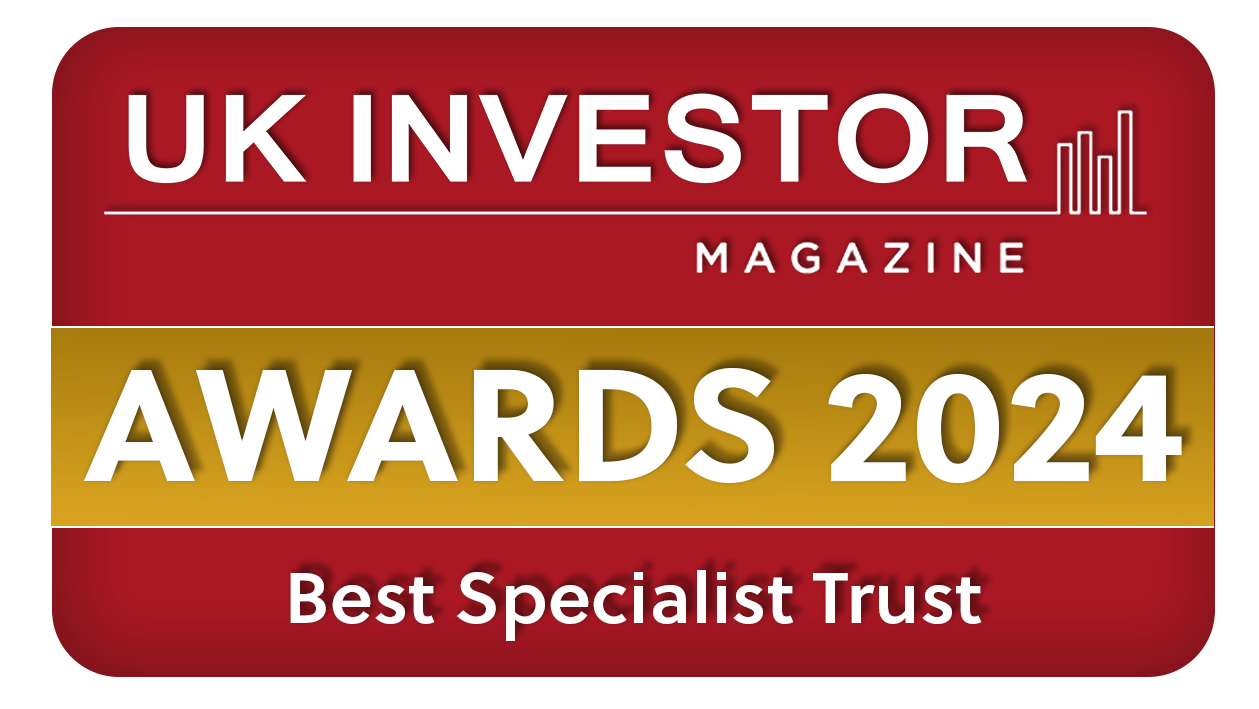


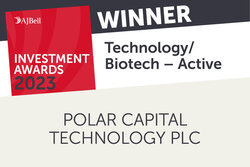
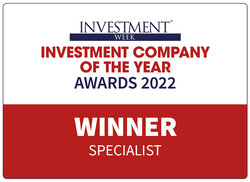
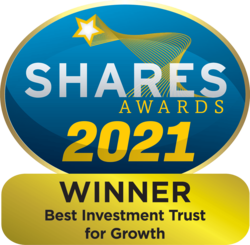

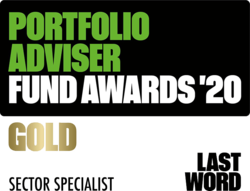
Fund Manager Commentary As at 30 September 2025
Key events
Market review
Global equity markets rallied in September, the MSCI All Country World Net Total Return Index returned +4%, the S&P 500 Index +4% and the DJ Euro Stoxx 600 +2.4% (all returns in sterling terms).
The US dollar weakened modestly over the month, while Bitcoin increased +5.8%. Commodities were mixed with copper rallying on growing evidence of a capital expenditure (capex)-led upcycle tied to AI power infrastructure, while oil was down -1.4% on Middle East supply concerns as demand signals softened slightly.
A strong September meant equity markets continued their third quarter rebound as economic data improved modestly. The labour market softened sufficiently to allow the Federal Reserve (Fed) to cut interest rates in September, the first reduction since last December. Tariff headlines continued but prompted more muted market reactions. Encouragingly earnings estimates were revised higher, including those for small companies. It is rarely mentioned that most of the S&P 500 gains this year – and since 2020 – have been driven by earnings. Strong earnings growth has also underpinned robust technology sector performance. Asian markets were particularly strong with new all-time highs recorded in Japan, South Korea, Taiwan, Australia and Singapore.
As expected, the Fed cut rates by 25 basis points (bps[1]) in September, lowering the Fed funds range to 4-4.25% on signs of a weakening labour market. Chair Jerome Powell emphasised this, acknowledging “meaningful weakness” in employment but describing current policy as only “modestly restrictive”. The Fed’s Summary of Economic Projections now signals three rate cuts in 2025 and a terminal rate of 3-3.25%.
Meanwhile, the European Central Bank paused its rate-cutting cycle, while in China growth continues to surprise to the upside, with exports resilient despite higher US tariffs. US economic data remained mixed, with August payrolls rising just 22,000 and the unemployment rate edging up to 4.3%, the highest of the cycle.
Tariffs continue to distort the inflation picture which is why policymakers still consider them to be a one-off adjustment. Towards month-end, investors were given a stark reminder that tariffs remain in play when President Trump announced a new set of sectoral tariffs, including a 100% rate on branded or patented pharmaceutical products. Section 232 tariffs have been widely expected for some time, but a Wall Street Journal article flagging a required 1:1 ratio of domestic to imported semiconductor chips, with any additional imports incurring a 100% tariff, was new news. Trump’s intention to bring 50% of chip production back onshore to the US is clear, with increasing US investment likely, particularly given the accelerated depreciation initiatives embedded in the president’s One Big Beautiful Bill.
Technology review
There were several notable earnings reports from holdings during the tail end of earnings season. Within software, Oracle delivered an extraordinary report in which RPO (remaining performance obligation; a measure of total contracted future revenue, yet to be recognised) surged to $455bn, up 359% y/y, after signing several multi-billion-dollar AI contracts, the largest of which is believed to be with OpenAI. Further multi-billion-dollar customers are expected to be signed in the coming months, with management highlighting insatiable demand for AI infrastructure. The contracts are primarily for AI training, but the inference market is expected to be larger in time.
In the semiconductor sector, Broadcom reported robust results and guidance, with revenue growth expected to accelerate to +24% y/y next quarter. AI semiconductor revenue is expected to be $6.2bn, driven by networking growth and increased volumes at its large XPU (custom AI compute) customers. Encouragingly, management also announced that ‘customer four’ (thought to be OpenAI) has moved from a prospect to a full customer, ordering $10bn+ of XPUs to be delivered in a single quarter next year. It added it now expects AI semiconductor revenue growth to 'improve significantly’ from what they had indicated last quarter (+50-60%). Lastly, Hock Tan announced that he would remain CEO through 2030 at least.
Micron Technology, a leading memory provider, delivered strong results with revenue +46% y/y, driven by strength in dynamic random-access memory (DRAM). Next-quarter guidance was well ahead of consensus expectations and management expects further gross margin expansion in the following quarters. Commentary on the company’s next-generation high bandwidth memory (HBM4) was constructive, with the technology exceeding NVIDIA’s specifications, although the company has not yet finalised 2026 supply agreements and is not “sold out” for the year. Leading hard disk drive (HDD) manufacturer Seagate Technology Holdings benefited from Micron Technology’s results.
High-speed connectivity solutions provider Credo Technology Group Holding reported revenue up an impressive +274% y/y, driven by AI-related demand for its active electrical cables (AEC), ethernet retimers and optical data signal processors. Both next-quarter and full-year guidance also came in well ahead of expectations. Customer concentration remains a significant overhang but declined during the quarter. This progress will hopefully continue as a fourth hyperscaler (the collective name for the largest cloud providers) customer is expected to reach 10% of revenue this year while a fifth has entered production.
Alphabet rallied after a judge blocked some of the Department of Justice’s more aggressive remedies in the Google antitrust case. The company’s product release cadence also accelerated through the month, with further integration of Gemini within Chrome and a new video generation model, Nano Banana. This led to less pressure around the AI-driven bear narrative on search disruption. Apple (a large u/w) also benefited from a favourable ruling in the Google antitrust case, which did not impact Apple’s default search engine revenue from Alphabet. In addition, better-than-expected initial order data for the iPhone 17 supported Apple’s share price strength.
On a less positive note, Advanced Micro Devices (AMD) lagged during the month as sentiment was impacted by NVIDIA’s partnership and investment in OpenAI. Thankfully, the stock rallied sharply in early October, when it emerged AMD had also signed a huge contract with OpenAI.
Outlook
Despite concerns about AI fatigue and challenging seasonality, September further underscored AI’s primacy as the driver of equity market performance amid easing financial conditions. AI has expanded from a pure tech story to a macro driver because of the investment cadence in compute, power, energy grids and data networks. Goldman Sachs estimates the rapid expansion of AI workloads will lead to a 165% rise in power requirements by 2030 versus 2023, with 60% of future needs requiring new generation capacity. Shortages in turbines, transformers, cooling systems and memory chips remain key bottlenecks, but the data points and the magnitude of spending commitments for the AI story continue to surprise to the upside, signalling the intensifying AI arms race.
OpenAI is setting an eyewatering pace in securing future AI infrastructure capacity with many deals in the last month alone, with NVIDIA announcing plans to invest up to $100bn into OpenAI. OpenAI also signed a strategic partnership with Samsung Electronics and SK Hynix for its Stargate AI infrastructure project.
OpenAI’s growing demand for advanced memory chips highlights just how rapidly artificial intelligence is driving the need for new technology infrastructure. The company is expected to require enough memory production to use almost half of today’s global manufacturing capacity. Building that much new capacity would be enormously expensive – potentially adding $112bn in new investment across the semiconductor industry. That level of spending would be comparable to the entire current market for the specialised equipment used to make these chips, underscoring how powerful AI-related demand could be for the broader technology supply chain.
Following the month-end, AMD also signed a deal with OpenAI, with AMD issuing OpenAI with performance-based warrants for 160 million AMD shares, around 10% of the company, tied to deployments and significant stock price performance. The deal should add double-digit billions in incremental AI revenue for AMD as it ramps, as well as being accretive to earnings from the outset with additional hyperscaler deals likely to follow, according to management. These announcements fit with bullish outlooks from Oracle ($455bn in bookings) and Broadcom, who guided to accelerating AI semiconductor revenue growth in 2026 and announced that the CEO’s compensation is tied to AI semiconductor business increasing 6x in five years from a $20bn base.
It is impossible to know how long this investment phase might last but NVIDIA’s CEO Jensen Huang has suggested that the world will be spending $3-4trn per year on AI infrastructure by 2030, up from <$1trn this year. All in, the incremental cost of power for greater AI data centre capacity that is expected to be added between 2025 and 2030 (according to McKinsey) is $7trn. Brookfield’s CFO, who is deploying actual capital rather than writing reports, sees $7trn of AI infrastructure investment required over the next decade. NVIDIA believes each gigawatt (GW) will cost $50-60bn, of which $35-40bn might be allocated to compute. OpenAI’s long-term goal is 250GW of capacity by 2033, which – perhaps best taken seriously rather than literally at this stage – would represent c25% of the entire US electrical generation capacity.
Investors are understandably worried by both the size and the circular nature of some of these OpenAI deals. However, looked at differently, these are the companies with the clearest view of the potential of AI and/or progress to AGI (artificial general intelligence) and they, along with the major hyperscalers, are materially accelerating investments. In addition, while OpenAI’s commitments far exceed its current deals relative to its $13bn revenue run rate, hyperscalers are funding capex from cashflow, in contrast to historic, debt-driven infrastructure cycles.
Bank of America believes that some of the largest technology companies – NVIDIA, Microsoft, Alphabet, Amazon and Meta Platforms – could access enormous amounts of additional funding if they chose to take on more debt. Based on Bloomberg estimates, modestly increasing their borrowing to typical corporate levels could free up close to $1trn in additional financial capacity. This highlights the significant financial firepower these companies could deploy to invest in artificial intelligence and related technologies.
Faced with competitors with deep pockets, perhaps the greatest threat to OpenAI is insufficient access to capacity, which may well explain the circular nature of these deals, as it cannot afford not to invest aggressively now.
Morgan Stanley estimates that the six largest AI capex spenders (Amazon, Alphabet, Meta Platforms, Microsoft, Oracle and CoreWeave) will pass $500bn in 2026 and near $600bn in 2027, which is impressive growth but still appears potentially conservative against the scale and cadence of hyperscaler AI infrastructure commitments. Investors are focused on the potential return on this intense capital investment in AI infrastructure, although we take comfort that since 2022 backlog growth for hyperscalers (including Oracle) has grown by $700bn, or 213% greater than the increase in capex. We are also encouraged by the fact that all hyperscalers are still capacity-constrained versus the demand for AI compute they are seeing, despite their aggressive investments to date.
Usage is certainly exploding too with Google Gemini processing around one quadrillion tokens in June (up from 480 trillion 90 days earlier), a number backed by NVIDIA who recently stated that token generation is doubling every two months. The Gemini app had more than 450 million monthly active users (MAU) at end of July with daily requests up >50% Q2 over Q1 while OpenAI has grown to 800 million MAU in August, from 700 million in July.
As a recent Morgan Stanley note, following a roadshow with NVIDIA management, put it: "While the three-year outlooks implied by some recent agreements may or may not realistically frame the absolute opportunity, they are so far ahead of what is in Street models that if even a fraction of those opportunities play out there is still material upside to consensus numbers for multiple years." Indeed, sustained aggressive hyperscaler AI capex investment is likely to be ahead of analysts’ expectations, driving further upside to estimates. Heading into 2024, consensus expectation was for 15% AI capex growth, and the reality was 55%. For 2025, the initial expectation was 20% and the reality is likely to be 50%+, according to Goldman Sachs data. The current expectation for 2026 is c20% again, because analysts are forecasting in linear fashion, but they are missing the fact we appear to be experiencing a rare moment of discontinuous technology progress.
Fundamental AI progress continues to impress. OpenAI disclosed information about how ChatGPT is being used by c10% of the global adult population – remarkable after just three years. OpenAI’s annual recurring revenue (ARR) has reached $13bn, up from $6bn in January and rival Anthropic’s ARR has reached $5bn, tripling from $1.5bn in January. Corporate AI adoption also appears to be inflecting. The Ramp AI Index includes >40,000 American businesses using Ramp corporate cards and indicates that c45% of US businesses now have paid subscriptions to AI models, platforms and tools, up from 23% at the start of the year and 15% at the start of 2024. Labour productivity continues to expand more rapidly than its pre-pandemic pace, as firms increase efficiencies – a priority when coming out of the pandemic when it was difficult to find workers, now augmented by the adoption and expected future improvement of powerful AI tools.
It is also our belief that we have finally reached the tipping point where investors need to reduce exposure to long-held – and increasingly ‘cheap’ – cloud computing era winners including some of the Mag7 in particular, software and many passive vehicles. While almost all companies are talking about AI now, those stocks, ETFs and funds that are trailing an AI-led market appear to not have fully embraced it. As a result, turnover within the Trust has been higher than normal because we consider the opportunity cost of holding laggards to be too high in this environment. We have also benefited from our AI Fund and the invaluable experience and focus this has given us over the past seven years, enabling us to move with confidence into the power and cooling theme – one of the most critical AI bottlenecks today.
Our conviction on AI’s proliferation based on the fundamental data points we monitor remains strong as we head towards Q3 earnings season. Of course, after such strong performance, periods of volatility should be expected but we consider these normal features of new cycles and something investors must be able and willing to tolerate.
The Trust continues to hold a modest amount out of the money NASDAQ puts[2] to ameliorate some of the excess beta[3] compared to tech indices in the event of a more material market setback, but it should be noted these are not to protect absolute returns. Valuations are elevated but not unreasonably given the significant upside to estimates should recent (remarkable) capex announcements come to pass.
[1] A basis point is a common unit of measure for interest rates and other percentages in finance; one basis point equals 0.01%
[2] A put option grants the right to the owner to sell some/all of an underlying security at a specified price, on or before the option's expiration date
[3] A measure of a stock's volatility compared to the market/ an index; the market/index has a beta of 1 with each stock rated at +/-1 in comparison
Ben Rogoff
Ben joined Polar Capital in May 2003. He is lead manager of Polar Capital Technology Trust plc and is a Fund Manager of the Polar Capital Global Technology Fund and Polar Capital Artificial Intelligence Fund.
Alastair Unwin
Alastair joined Polar Capital in June 2019 as a Fund Manager. Prior to joining Polar Capital, Alastair co-managed the Arbrook American Equities Fund. Between 2014 and 2018 he launched and then managed the Neptune Global Technology Fund and managed the Neptune US Opportunities Fund. Prior to Neptune, Alastair was a technology analyst at Herald Investment Management.
Historical Fact Sheets